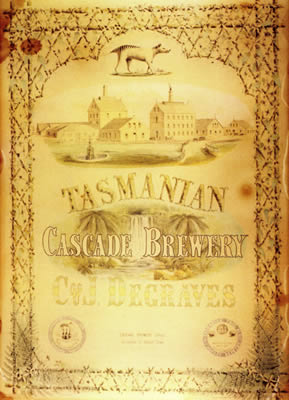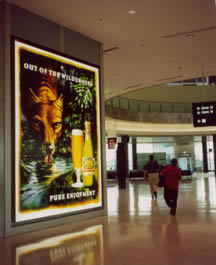The Commercial Thylacine

W. C. Piguenit, advertisement for C. and J. Degraves’
Cascade Brewery, Hobart. 1870.
enlarge image |
The figure of the thylacine is a vital element in the cultural, commercial and economic life of Tasmania. In the early 1990s, the thylacine and Tasmania were even more firmly linked through the processes of representation used in advertising, branding and logos. The association between the two usually centres on the unique or distinctive qualities of both. Since the early twentieth century the species has been referred to as ‘the world's largest carnivorous marsupial’ and now Tasmania is one of ‘the last great unspoilt wilderness areas of the world’
Cascade Brewery in Hobart has a long history of using the image of a thylacine in its advertising. As early as 1870, colonial artist W.C. Piguenit produced a poster for the brewery with a small picture of the animal on the top and a label design on the bottom left hand corner. The poster projects the qualities Tasmania is still believed to possess – those of a pristine and wild environment. |
Today, Cascade Brewery’s beer label still plays on elements of wildness that are perceived to apply to both the animal and the island. The highly visible stripes down the thylacines' tails, together with an assertive stance, threatening glower and dark background, produce an eye-catching label that is highly effective in a competitive market.
A recent Cascade advertisement uses the thylacine as an invitation to visit Tasmania: the approachable dog-like figure drinking from a pool acts as an enticement to search for the species. The landscapes in early illustrations of the thylacine – rugged mountains and mysterious forests – were used to suggest that they were dangerous, wolf-like animals and a threat to the pastoral industry. Here the figure is used to evoke the attractions of wilderness to tourists from urban areas.
Huge versions of this ad were posted in Australian airport lounges, where they promoted beer as well as Tasmania as a destination where visitors might glimpse the rare and elusive thylacine.
|
 Cascade Premium lager advertisement at
Cascade Premium lager advertisement at
Kingsford Smith Airport, Sydney |
There are hundreds of images of the thylacine in advertising, on company logos, and as souvenirs. While the extinction of the species exemplifies the devastating effects of European culture on fauna, flora and indigenous human populations, the figure of the thylacine is now a container for messages crucial for tourism, commerce and State identity, rather than conveying ideas about the need for biodiversity.
And there is another perspective on the use of Australian animals in advertising:
These native animals are part of our people and it is an insult the way they are being used ... They steal our land and they steal our animals and then they use them as their signs. Cascade should use a fox on its labels instead. That's what they [Europeans] brought with them.
Rodney Dillon, Tasmanian Aboriginal and Torres Strait Islander Commissioner, The Mercury, January 31, 2002.
|

Tasmanian thylacine souvenirs
|
|
|